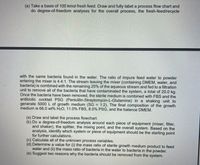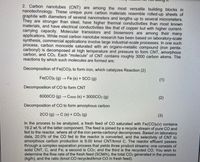
Introduction to Chemical Engineering Thermodynamics
8th Edition
ISBN: 9781259696527
Author: J.M. Smith Termodinamica en ingenieria quimica, Hendrick C Van Ness, Michael Abbott, Mark Swihart
Publisher: McGraw-Hill Education
expand_more
expand_more
format_list_bulleted
Question

Transcribed Image Text:(a) Take a basis of 100 kmol fresh feed. Draw and fully label a process flow chart and
do degree-of-freedom analyses for the overall process, the fresh-feed/recycle
with the same bacteria found in the water. The ratio of impure feed water to powder
entering the mixer is 4.4:1. The stream leaving the mixer (containing DMEM, water, and
bacteria) is combined with the remaining 25% of the aqueous stream and fed to a filtration
unit to remove all of the bacteria that have contaminated the system, a total of 20.0 kg.
Once the bacteria have been removed, the sterile medium is combined with FBS and the
antibiotic cocktail PSG (Penicillin-Streptomycin-L-Glutamine) in a shaking unit to
generate 5000L of growth medium (SG = 1:2). The final composition of the growth
medium is 66.0 wt% H2O, 11.0% FBS, 8.0% PSG, and the balance DMEM.
(a) Draw and label the process flowchart.
(b) Do a degree-of-freedom analysis around each piece of equipment (mixer, filter,
and shaker), the splitter, the mixing point, and the overall system. Based on the
analysis, identify which system or piece of equipment should be the starting point
for further calculations.
(c) Calculate all of the unknown process variables.
(d) Determine a value for (i). the mass ratio of sterile growth medium product to feed
water and (ii) the mass ratio of bacteria in the water to bacteria in the powder.
(e) Suggest two reasons why the bacteria should be removed from the system.

Transcribed Image Text:2. Carbon nanotubes (CNT) are among the most versatile building blocks in
nanotechnology. These unique pure carbon materials resemble rolled-up sheets of
graphite with diameters of several nanometers and lengths up to several micrometers.
They are stronger than steel, have higher thermal conductivities than most known
materials, and have electrical conductivities like that of copper but with higher current-
carrying capacity. Molecular transistors and biosensors are among their many
applications. While most carbon nanotube research has been based on laboratory-scale
synthesis, commercial applications involve large industrial-scale processes. In one such
process, carbon monoxide saturated with an organo-metallic compound (iron penta-
carbonyl) is decomposed at high temperature and pressure to form CNT, amorphous
carbon, and CO2. Each "molecule" of CNT contains roughly 3000 carbon atoms. The
reactions by which such molecules are formed are:
Decomposition of Fe(CO)s to form iron, which catalyzes Reaction (2)
Fe(CO)5 (g) → Fe (s) + 5CO (g)
(1)
Decomposition of CO to form CNT
6000CO (g) → C3000 (s) + 3000CO2 (g)
(2)
Decomposition of CO to form amorphous carbon
2C0 (g) C (s) + CO2 (g)
(3)
In the process to be analyzed, a fresh feed of CO saturated with Fe(CO)s(v) contains
19.2 wt.% of the latter component. The feed is joined by a recycle stream of pure CO and
fed to the reactor, where all of the iron penta-carbonyl decomposes. Based on laboratory
data, 20.0% of the CO fed to the reactor is converted, and the selectivity of CNT to
amorphous carbon production is 9.00 kmol CNT/kmol C. The reactor effluent passes
through a complex separation process that yields three product streams: one consists of
solid CNT, C, and Fe; a second is CO2; and the third
determine the flow rate of the fresh feed (SCM/h), the total CO2 generated in the process
(kg/h), and the ratio (kmol CO recycled/kmol CO in fresh feed).
the recycled CO. You wish to
Expert Solution
This question has been solved!
Explore an expertly crafted, step-by-step solution for a thorough understanding of key concepts.
This is a popular solution
Trending nowThis is a popular solution!
Step by stepSolved in 7 steps with 6 images

Knowledge Booster
Similar questions
- Describe with illustration the performance of two varieties of dryers used in the chemical Industry. What are the variables in dryer design that will enhance dryer efficiencyarrow_forward2. A 3-D printer was used to fabricate a porous cartilage scaffold using a hydrogel solution. The hydrogel (viscosity was 3 x 10 Pa-s) was added to the extruder, and a pressure of 5 bar was applied to extrude 500 mL of the solution over 10 minutes to form the desired shape. The needle attached to the extruder had a length of 50 mm and an inner diameter of 1.0 mm. Determine the pressure drop needed to complete this fabrication process.arrow_forward21. A plate and frame filter press is used to filter a compressible sludge (S = 0.45) at 50 psia for 2 hours. Washing is done at 30 psi with wash water equal to 10% of the filtrate volume collected. The washing time is a. 100 min b. 127 min c. 85 min d. 205 minarrow_forward
- b) A complete drying experiment for two different materials (sand and minced meat) was conducted in the laboratory. The results of drying rate for both materials are as shown in Figure 3. Compare and explain the drying rate behavior for sand and minced meat. Drying rate Sand Minced meat Drying time Figure 3 Relation between drying rate and drying timearrow_forwardIn a leaching operation, what is the leachant, the overflow, and the underflow?arrow_forward17.5. Identify the following polymer processing techniques as either: (i) Continuous (able to operate for very long periods of time as long as enough polymer is supplied), (ii) Batch or semi-continuous (able to make one material at a time, or possibly operate in a cyclic or fashion for a long time with small breaks between processing) THERMAL EXTRUSION CASTING TO FORM A THERMOSET POLYMER BLOW MOLDING MELT SPINNING OF FIBERS THERMOFORMING - INJECTION MOLDING - BLOW EXTRUSION - CALENDERING - COMPOUNDING - ROTATIONAL MOLDING 17.6. You work at a plant that makes poly(ethylene terephthalate), PET, bottles using blow molding, but the production line is having a problem with lots of rejected bottles, which must be ground up and recycled. The rejected bottles sometimes have holes in the threaded part at the top of the bottle (where the screw-cap goes), or this part is often too thin and not rigid enough for the screw cap to fit snugly. A. Give a likely explanation of what is causing the…arrow_forward
- 6. A certain filter press when tested on a homogeneous slurry at constant rate yielded the following data. Time, min P - Ps, psi Filtrate, lb 1 10 3 8 30 5 10 50 11 60 10 15 100 20 25 200 30 35 300 If this press is to be operated at a constant pressure drop of 10 psi and the time for cleaning and washing between cycles is 20 min, compute the optimuin cycle time (time for filtra- tion, cleaning, and washing).arrow_forwardIn the dryer models for a belt dryer with throughcirculation and a direct-heat rotary dryer, is the rate of drying based on heat transfer or mass transfer? Why?arrow_forwardDraw a diagram of the industrial sugar evaporation process in a multiple effect evaporator and explain its operation.arrow_forward
arrow_back_ios
arrow_forward_ios
Recommended textbooks for you
 Introduction to Chemical Engineering Thermodynami...Chemical EngineeringISBN:9781259696527Author:J.M. Smith Termodinamica en ingenieria quimica, Hendrick C Van Ness, Michael Abbott, Mark SwihartPublisher:McGraw-Hill Education
Introduction to Chemical Engineering Thermodynami...Chemical EngineeringISBN:9781259696527Author:J.M. Smith Termodinamica en ingenieria quimica, Hendrick C Van Ness, Michael Abbott, Mark SwihartPublisher:McGraw-Hill Education Elementary Principles of Chemical Processes, Bind...Chemical EngineeringISBN:9781118431221Author:Richard M. Felder, Ronald W. Rousseau, Lisa G. BullardPublisher:WILEY
Elementary Principles of Chemical Processes, Bind...Chemical EngineeringISBN:9781118431221Author:Richard M. Felder, Ronald W. Rousseau, Lisa G. BullardPublisher:WILEY Elements of Chemical Reaction Engineering (5th Ed...Chemical EngineeringISBN:9780133887518Author:H. Scott FoglerPublisher:Prentice Hall
Elements of Chemical Reaction Engineering (5th Ed...Chemical EngineeringISBN:9780133887518Author:H. Scott FoglerPublisher:Prentice Hall
 Industrial Plastics: Theory and ApplicationsChemical EngineeringISBN:9781285061238Author:Lokensgard, ErikPublisher:Delmar Cengage Learning
Industrial Plastics: Theory and ApplicationsChemical EngineeringISBN:9781285061238Author:Lokensgard, ErikPublisher:Delmar Cengage Learning Unit Operations of Chemical EngineeringChemical EngineeringISBN:9780072848236Author:Warren McCabe, Julian C. Smith, Peter HarriottPublisher:McGraw-Hill Companies, The
Unit Operations of Chemical EngineeringChemical EngineeringISBN:9780072848236Author:Warren McCabe, Julian C. Smith, Peter HarriottPublisher:McGraw-Hill Companies, The

Introduction to Chemical Engineering Thermodynami...
Chemical Engineering
ISBN:9781259696527
Author:J.M. Smith Termodinamica en ingenieria quimica, Hendrick C Van Ness, Michael Abbott, Mark Swihart
Publisher:McGraw-Hill Education

Elementary Principles of Chemical Processes, Bind...
Chemical Engineering
ISBN:9781118431221
Author:Richard M. Felder, Ronald W. Rousseau, Lisa G. Bullard
Publisher:WILEY

Elements of Chemical Reaction Engineering (5th Ed...
Chemical Engineering
ISBN:9780133887518
Author:H. Scott Fogler
Publisher:Prentice Hall


Industrial Plastics: Theory and Applications
Chemical Engineering
ISBN:9781285061238
Author:Lokensgard, Erik
Publisher:Delmar Cengage Learning

Unit Operations of Chemical Engineering
Chemical Engineering
ISBN:9780072848236
Author:Warren McCabe, Julian C. Smith, Peter Harriott
Publisher:McGraw-Hill Companies, The